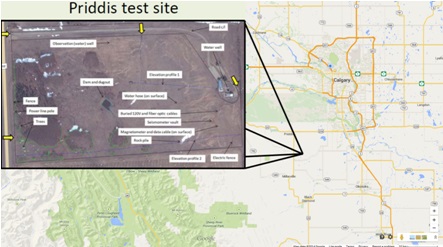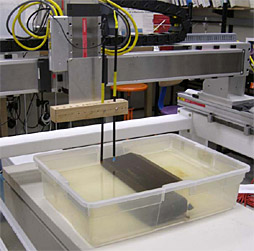Research Facilities
Computer Systems

Our computer systems include Linux servers, Linux clusters, and Windows workstations for 2-D and 3-D seismic processing, seismic interpretation, visualization, numerical modeling, and software development.
For more information about CREWES computer systems, contact Kevin Hall
(kwhallucalgary
ca).
Seismic Acquisition




CREWES is proud to have access to an ever expanding collection of commercial grade seismic and survey equipment. Most of the CREWES staff are eager to take acquisition ideas out of the office and test them in the field. It is also very beneficial for students to witness how the equipment is used to acquire data and some of the challenges that exist with acquisition.
The largest system currently accessible to CREWES is an Aram Aries (now Inova) system. This system can be configured to be used with 1C geophones and 3C geophones. This is a cabled system requiring that all ground equipment be connected to a recording system computer, called a Seismic Processing Module Lite (SPML). Although this system is made portable to be used in remote locations it is semi-permanently mounted into a box on the back of a Ford 450 truck, known as the recorder. The ground equipment is typically transported on the back of two Ford 350 trucks.
On a slightly smaller scale there is the Geometrics Geode system. This system is highly portable in that it can be carried into remote locations by a small team. This system is typically used with a hammer or thumper source and used for refraction surveys.
The newest recording system that CREWES has access to is the Inova Hawk nodal system. This differs from the previously mentioned system in that it is not a cabled system. All data is recorded into individual boxes and then downloaded at the end of the job. This system requires GPS timing to sync the source with the data recorded.
CREWES has access to several seismic sources. The largest is an IVI Envirovibe. This unit is small enough to be towed on a trailer by a Ford 550 truck and have a low enviromental impact. Typically it is used to run ten to twenty second sweeps from ten hertz to two to three hundred hertz.
Click on the image below to see a slow motion video of the vibe in action
There is also a custom built thumper trailer. This thumper uses a nitrogen spring to accelerate a mass towards the "foot". This trailer has the unique ability to have the mass tilt to strike the foot at a forty five degree angle to act as an S-wave thumper.
For smaller surveys we also use a sledge hammer and plate.
All of this equipment is used to perform field tests and experiments and to train students within CREWES and the University of Calgary Geophysics program.
Priddis test site.
The University of Calgary has some property southwest of Calgary where the Rothney Astrophysical Observatory is located. This is a conveniant area to perform field tests. This property has three test holes installed, one with permanent 3C geophones installed.

Brooks CMC site.
Carbon Management Canada has access to a large field southwest of Brooks, Alberta. Thanks to a close relationship with this group CREWES has been able to carry out some seismic experiments at this location.
Physical Modelling


Controlled by a computer, the system moves transducers around the model to simulate surface seismic, marine seismic, borehole seismic, and hybrid surface/marine surveys. The system can be fitted with a variety of P- and S-wave transducers, or hydrophones.
This system is currently being used to acquire simluated marine surveys, but can also be used to acquire multicomponent surveys, employing P wave transducers for a source, and P- and S-wave transducers for receivers.
Click on the image below to see a time-lapse of the physical modelling system in action
For more information regarding physical modelling, contact Joe Wong
(wongjoeucalgary
ca).
